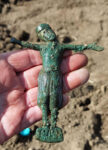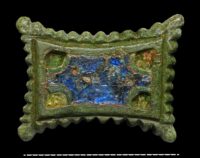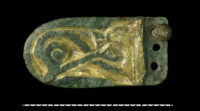 The remains of a church built in the 10th century by the first Holy Roman Emperor have been discovered under a cornfield near Eisleben, in Saxony-Anhalt, northeastern Germany. State archaeologists have been excavating the site of the royal palace of Helfta built by Holy Roman Emperor Otto I west of modern-day Eisleben.
The remains of a church built in the 10th century by the first Holy Roman Emperor have been discovered under a cornfield near Eisleben, in Saxony-Anhalt, northeastern Germany. State archaeologists have been excavating the site of the royal palace of Helfta built by Holy Roman Emperor Otto I west of modern-day Eisleben.
Since digs began in May, the team has unearthed the foundation walls of a classic three-aisled cruciform basilica about 98 feet long and 66 feet wide with a transept and semicircular apse on the east end. Church-related artifacts found so far include a Romanesque bronze crucifix with enamel, a prestigious object made in Limoges in the 13th century, and a large piece of a church bell.
 The church was founded around 968 by Holy Roman Emperor Otto the Great who had moved to Rome two years earlier to take a more hands-on approach in his unruly relations with the papacy and widen his sphere of influence in Italy. Building large, showy churches in Germany, especially in his ancestral duchy of Saxony, was part of his program to establish himself as Emperor of the Romans and the newly-minted Holy Roman Empire as the true papal-approved successor to the Roman Empire. (The Byzantine emperor begged to differ.)
The church was founded around 968 by Holy Roman Emperor Otto the Great who had moved to Rome two years earlier to take a more hands-on approach in his unruly relations with the papacy and widen his sphere of influence in Italy. Building large, showy churches in Germany, especially in his ancestral duchy of Saxony, was part of his program to establish himself as Emperor of the Romans and the newly-minted Holy Roman Empire as the true papal-approved successor to the Roman Empire. (The Byzantine emperor begged to differ.)
Historian Thietmar von Merseburg wrote in his early 11th century chronicle that the church at Helfta was dedicated to Saint Radegund, a 6th century Thuringian princess who dumped her husband Merovingian Frankish King Chlothar I in favor of an ascetic religious life. Theitmar also recorded that Otto the Great had been personally present when the church was inaugurated.
 More than 70 graves including brick and stone tombs from the 10th through the 15th centuries have been found inside the church precinct and in the adjacent cemetery. Objects recovered include a gilded belt buckle, coins, knives and several enameled bronze brooches. which was the final resting place for many of the region’s elite. Thietmar’s account describes one such burial. It was his own relative Count Werner von Walbeck, whose remains were transported from Walbeck to be buried in the churchyard in 1014. The body was in an advanced state of decomposition, so Thietmar had the entrails removed and buried in the cemetery in lieu of the fully intact corpse.
More than 70 graves including brick and stone tombs from the 10th through the 15th centuries have been found inside the church precinct and in the adjacent cemetery. Objects recovered include a gilded belt buckle, coins, knives and several enameled bronze brooches. which was the final resting place for many of the region’s elite. Thietmar’s account describes one such burial. It was his own relative Count Werner von Walbeck, whose remains were transported from Walbeck to be buried in the churchyard in 1014. The body was in an advanced state of decomposition, so Thietmar had the entrails removed and buried in the cemetery in lieu of the fully intact corpse.
Martin Luther was born and died in Eisleben, and it was the Reformation he sparked that cause the church’s ultimate destruction. For 500 years it dominated the landscape and religious life of the area. Come the fury of the Protestant Reformation, its walls were torn down to its foundations and its very location obliterated from the record.
The excavation of the site will continue until early September and will widen the dig area to the area around the church. Archaeologists hope to unearth remains of the settlement and fortifications the grew around the Ottonian royal palace.


Otto resolved the issues with the Byzantine emperor, and the Byzantine princess Theophanou married his son Otto II in April 972.
“That Greek woman” –as she was referred to by her mother-in-law– is buried in The Church of Saint Pantaleon in Cologne, which might give an idea of what that destroyed Saxon church might have looked like:
en.wikipedia.org/wiki/Theophanu#Empress
en.wikipedia.org/wiki/Church_of_St._Pantaleon
upload.wikimedia.org/wikipedia/commons/0/06/Koeln_stpantaleon_sarkophag_theophanu.jpg
en.wikipedia.org/wiki/Ottonian_Renaissance
A similar thing happened in Walkenried, where the Reformation resulted in an all but total destruction of the monastery church. A few wall fragments are left standing. The Walkenried monastery once was one of the most rich and powerful ones in northern Germany.
I’m a protestant myself but man, I wish the early protestants would have had more respect for art and culture 🙁
Wasn’t Charlemagne the first Holy Roman Emperor? Alos, might need an edit here: “Objects recovered include a gilded belt buckle, coins, knives and several enameled bronze brooches. which was the final resting place for many of the region’s elite.”
…“not so Holy Westroman Emperor”, Dr. E. 😉
There were East Romans and West Romans. Already in 476AD, what today is Italy had been taken over by Odoacer from the West Roman Empire, and after that –i.e. with all that “Migration”– it gets a bit complicated, e.g. Gothic and Vandal Intervals, pirates, islamists, and temporarily East Roman control (a.k.a. “Byzantine” archates).
Indeed, “Charlemagne” (Carolus) was crowned (West) “Roman Emperor”, but not as a “Holy” one. To be precise, he was Frankish, his realm divided in “partes tres” after his death (cf. “Treaty of Verdun” in 834AD), and later –with East Francia (a.k.a. “Francia orientalis”, i.e. mainly what today is Germany)– the Holy Roman Empire was established.
thank you so much for this fascinating post (and all your posts, I lurk here daily). AND for correctly identifying Otto as the first Holy Roman Emperor…so nice to see.
What today is the distinct German states of “Saxony”, “Thuringia” and “Lower Saxony” is not necessarily “fully identical” to where the “Thuringians” and the “Saxons” used to live 1500 years ago.
That the Thuringian princess Radegund “dumped her husband Merovingian Frankish King Chlothar I in favor of an ascetic religious life” might be due to “post traumatic stress”, to say the least 😮
In the “Battle at the Unstrut River” (531AD) the Franks defeated the Thuringian army, led by their king Hermanfrid (her uncle), and Redegund and her brother ended up in Frankish control, were they received an education.
By 550, her brother was the surviving male member of the Thuringian royal family, and Clothar I, who had made Radegund one of his six wives and/ or concubines, had him murdered.
Consequently, Radegund fled the court and sought the protection of the Church, persuading the bishop of Noyon to ordain her as founding deaconess in a monastery in Poitiers in circa 560, where she cared for the infirm.